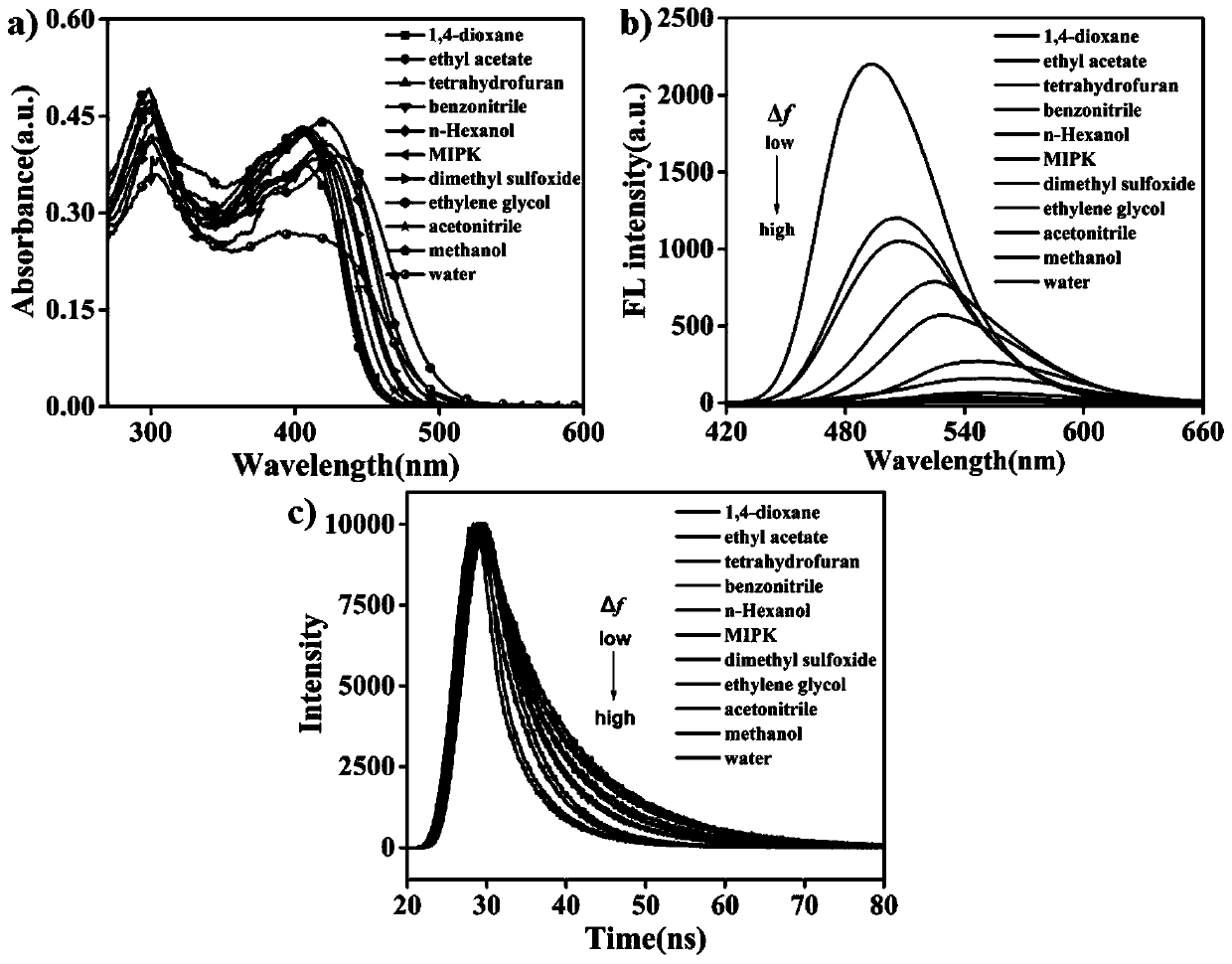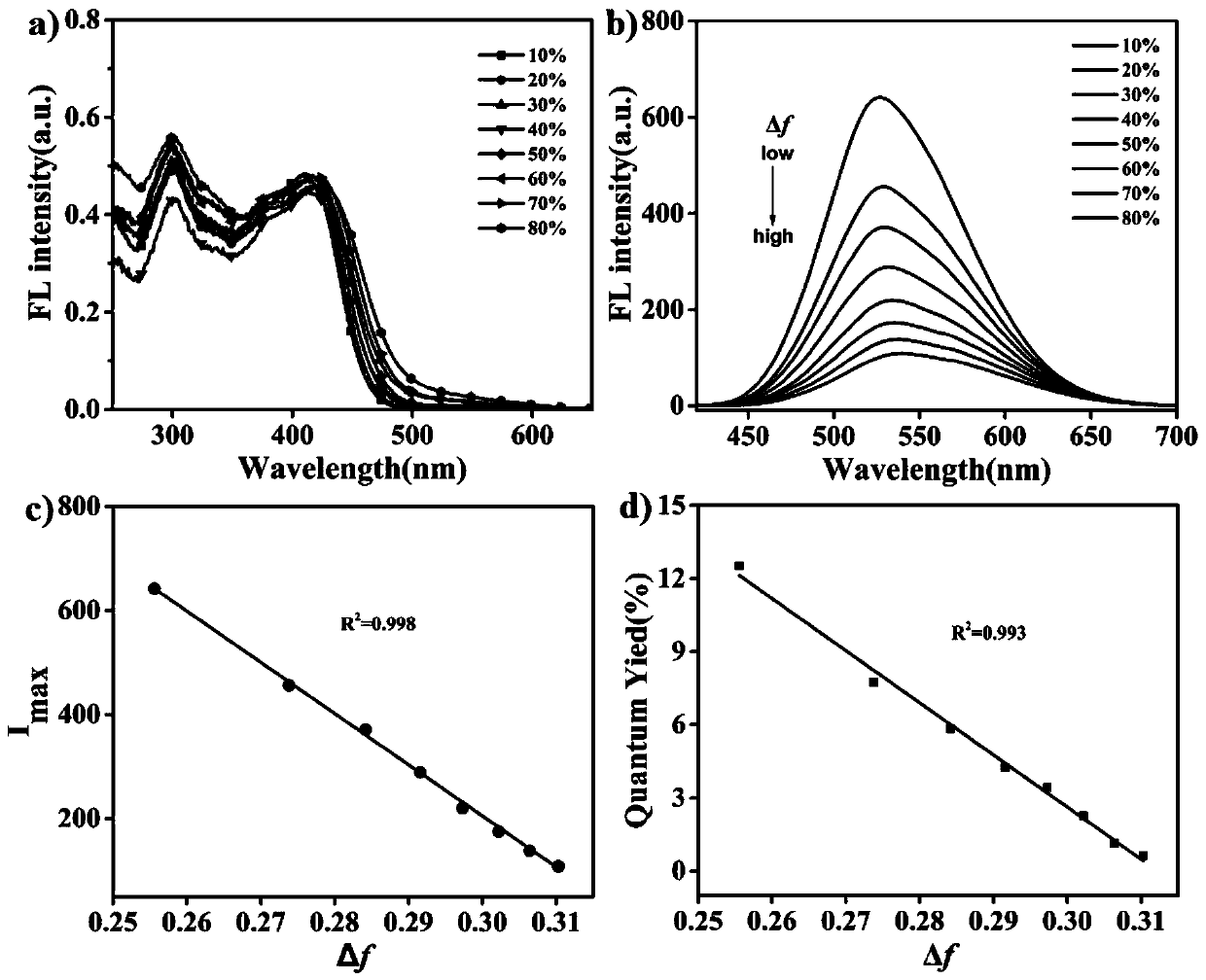Two-photon polar fluorescent probe based on carbazole and preparation method and application of two-photon polar fluorescent probe
A fluorescent probe, two-photon technology, applied in fluorescence/phosphorescence, chemical instruments and methods, luminescent materials, etc., can solve rare problems and achieve the effects of easy synthesis, good lysosome positioning ability, and good cell permeability
- Summary
- Abstract
- Description
- Claims
- Application Information
AI Technical Summary
Problems solved by technology
Method used
Image
Examples
Embodiment 1
[0034] Embodiment 1: the synthesis of compound 1
[0035] In a 500mL round bottom flask, KOH (260mmol, 14.63g) was dissolved in an appropriate amount of acetone (200mL), stirred at room temperature for 30 minutes, and then 3-bromocarbazole (52mmol, 2.80g) dissolved in acetone was added to the above solution , stirred at room temperature for 4 hours, finally slowly added bromoethane (78mmol, 6mL) dissolved in acetone, stirred overnight at room temperature, filtered off the KOH solid after the reaction was completed, and spin-dried with a rotary evaporator. Methane chloride was dissolved, silica gel sample preparation, column chromatography separation, using petroleum ether:dichloromethane (PE:DCM, v / v, 50:1) as eluent, purified to obtain compound 1, white flocculent solid, product: 11.12 g, yield: 78%. 1 H NMR (400MHz, DMSO-d 6 ,ppm)δ8.40(d,J=1.5Hz,1H),8.21(d,J=7.7Hz,1H),7.65–7.54(m,3H),7.49(ddd,J=8.3,7.2,1.2Hz ,1H),7.25–7.18(m,1H),4.44(q,J=7.1Hz,2H),1.30(t,J=7.1Hz,3H). 13 ...
Embodiment 2
[0036] Embodiment 2: the synthesis of compound 2
[0037] use CH 2 Cl 2 Dissolve compound 1 (33mmol, 9.05g) in 500mL round bottom flask, under the state of stirring, add AlCl rapidly 3 (72.2mmol, 9.63g), then cooled to 0 ° C, and then CH 2 Cl 2 Dissolved acetic anhydride (36mmol, 3.68g) was added dropwise to the above solution, and for about ten minutes, the stirring was increased, and the ice-salt bath device was removed, and the room temperature was reacted overnight. 2 Add O and HCl to the mixed solution and extract with dichloromethane for more than two times, and then use 1mol / L NaHCO 3 The aqueous solution was washed with water, followed by extraction with water and dichloromethane twice. Anhydrous MgSO for organic phase 4 Dry and filter again, remove the organic solvent by a rotary evaporator, dissolve the remaining solid with an appropriate amount of dichloromethane, prepare a sample on silica gel, separate by column chromatography, and use petroleum ether: ethyl...
Embodiment 3
[0038] Embodiment 3: the synthesis of compound 3
[0039] Weigh compound 2 (10mmol, 3.162g) and potassium tert-butoxide (10mmol, 1.12g) in a 250mL round bottom flask, add an appropriate amount of tetrahydrofuran (100mL) to dissolve, stir well at room temperature, and slowly Diphenylamino-4-benzaldehyde (12mmol, 3.28g) dissolved in tetrahydrofuran was added dropwise. After the dropwise addition, the temperature was set at 50°C and the reaction was carried out overnight. After the reaction was completed, the tetrahydrofuran was removed with a rotary evaporator, and the remaining mixture was Extract with dichloromethane and water three times to remove inorganic salts, collect the organic phase, and use anhydrous MgSO 4 Dry and filter again, remove the organic solvent by a rotary evaporator, dissolve the remaining solid with an appropriate amount of dichloromethane, prepare a sample on silica gel, separate by column chromatography, use petroleum ether: ethyl acetate (PE: EA, v / v, ...
PUM
 Login to View More
Login to View More Abstract
Description
Claims
Application Information
 Login to View More
Login to View More - R&D
- Intellectual Property
- Life Sciences
- Materials
- Tech Scout
- Unparalleled Data Quality
- Higher Quality Content
- 60% Fewer Hallucinations
Browse by: Latest US Patents, China's latest patents, Technical Efficacy Thesaurus, Application Domain, Technology Topic, Popular Technical Reports.
© 2025 PatSnap. All rights reserved.Legal|Privacy policy|Modern Slavery Act Transparency Statement|Sitemap|About US| Contact US: help@patsnap.com



